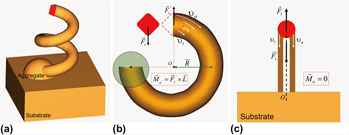Crossref Citations
This article has been cited by the following publications. This list is generated based on data provided by
Crossref.
Cervantes-Sodi, Felipe
Vilatela, Juan J.
Jiménez-Rodríguez, José A.
Reyes-Gutiérrez, Lucio G.
Rosas-Meléndez, Samuel
Íñiguez-Rábago, Agustín
Ballesteros-Villarreal, Mónica
Palacios, Eduardo
Reiband, Gerd
and
Terrones, Mauricio
2012.
Carbon nanotube bundles self-assembled in double helix microstructures.
Carbon,
Vol. 50,
Issue. 10,
p.
3688.
Li, Dawei
Pan, Lujun
Liu, Kun
Peng, Wei
and
Muhammad, Rashad
2013.
Growth of multiwall carbon nanocoils using Fe catalyst films prepared by ion sputtering.
Journal of Materials Research,
Vol. 28,
Issue. 10,
p.
1316.
Cui, Ruixue
Pan, Lujun
Li, Dawei
Ma, He
and
Peng, Wei
2014.
Controlled synthesis of carbon nanocoils and carbon nanotubes on common paper substrates.
Carbon,
Vol. 76,
Issue. ,
p.
455.
Suda, Yoshiyuki
Ishii, Yuichi
Miki, Tatsuki
Maruyama, Koji
Tanoue, Hideto
Takikawa, Hirofumi
Ue, Hitoshi
Shimizu, Kazuki
and
Umeda, Yoshito
2014.
Improvement of carbon nanocoil purity achieved by supplying catalyst molecules from the vapor phase in chemical vapor deposition.
Journal of Materials Research,
Vol. 29,
Issue. 18,
p.
2179.
Qi, Xiaosi
Xu, Jianle
Zhong, Wei
and
Du, Youwei
2015.
Synthesis of high purity chain-like carbon nanospheres in ultrahigh yield, and their microwave absorption properties.
RSC Advances,
Vol. 5,
Issue. 21,
p.
16010.
Gohara, Takehiro
Takei, Kuniharu
Arie, Takayuki
and
Akita, Seiji
2015.
Reduction of carbon byproducts for high-purity carbon nanocoil growth by suppressing catalyst collision.
Carbon,
Vol. 89,
Issue. ,
p.
225.
Qi, Xiaosi
Xu, Jianle
Zhong, Wei
and
Du, Youwei
2015.
High yield synthesis and photoluminescence properties of carbon coils over Al2O3 substrates.
Diamond and Related Materials,
Vol. 51,
Issue. ,
p.
30.
Suda, Yoshiyuki
Maruyama, Koji
Iida, Tetsuo
Takikawa, Hirofumi
Ue, Hitoshi
Shimizu, Kazuki
and
Umeda, Yoshito
2015.
High-Yield Synthesis of Helical Carbon Nanofibers Using Iron Oxide Fine Powder as a Catalyst.
Crystals,
Vol. 5,
Issue. 1,
p.
47.
Fu, Xin
Pan, Lujun
Li, Dawei
Zhou, Nan
and
Sun, Yanming
2015.
Controlled synthesis of carbon nanocoils with selective coil diameters and structures by optimizing the thickness of catalyst film.
Carbon,
Vol. 93,
Issue. ,
p.
361.
Cui, Ruixue
Pan, Lujun
and
Deng, Chenghao
2015.
Synthesis of carbon nanocoils on substrates made of plant fibers.
Carbon,
Vol. 89,
Issue. ,
p.
47.
Fu, Xin
Pan, Lujun
Wang, Qiao
Liu, Congyue
Sun, Yanming
Asif, Muhammad
Qin, Jun
and
Huang, Yingying
2016.
Controlled synthesis of carbon nanocoils on monolayered silica spheres.
Carbon,
Vol. 99,
Issue. ,
p.
43.
Cui, Ruixue
Pan, Lujun
Ma, He
Wang, Peng
and
Asif, Muhammad
2016.
Highly efficient synthesis of carbon nanocoils on alumina spheres.
RSC Advances,
Vol. 6,
Issue. 36,
p.
30125.
Suda, Yoshiyuki
2019.
Chemical Vapor Deposition for Nanotechnology.
Zhao, Yongpeng
Wang, Jianzhen
Huang, Hui
Zhang, Hao
Cong, Tianze
Zhang, Dongmei
Wen, Ningxuan
Zhang, Yifeng
Fan, Zeng
and
Pan, Lujun
2020.
Catalytic anisotropy induced by multi-particles for growth of carbon nanocoils.
Carbon,
Vol. 166,
Issue. ,
p.
101.
Zhao, Yongpeng
Wang, Jianzhen
Huang, Hui
Cong, Tianze
Yang, Shuaitao
Chen, Huan
Qin, Jiaqi
Usman, Muhammad
Fan, Zeng
and
Pan, Lujun
2020.
Growth of Carbon Nanocoils by Porous α-Fe2O3/SnO2 Catalyst and Its Buckypaper for High Efficient Adsorption.
Nano-Micro Letters,
Vol. 12,
Issue. 1,





